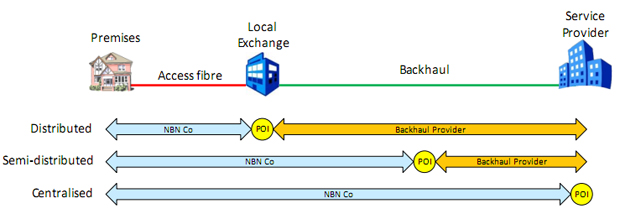120 POI avoids NBN 'mission creep': ACCC

The Federal Government will deploy 120 points of interconnect (POI) for retailers to tap into the National Broadband Network (NBN) in a move that has satisfied the competition regulator and big telcos but irked at least one telco chief.

PoI models(Credit: NBN Co)
The news was unveiled today in the much-awaited NBN business case (PDF) released by Federal Communications Minister Stephen Conroy.
The move is a change from NBN Co's original position, which proposed deploying only 14 POIs across capital cities, a plan contested by the Australia Competition and Consumer Commission (ACCC) in a report to Federal Government late last month.
The regulator argued that NBN Co would be exercising "mission creep" if it only had 14 POIs, since it would be extending its monopoly further than it needed. It said that it should drop that model and adopt a "semi-distributed approach" which would combine existing and new fibre infrastructure.
That model would see POIs located in areas serviced by two or more transmission operators, or where a transmission route is likely to become competitive.
Australia's largest three telcos, Telstra, Optus and iiNet, have previously pushed for a POI expansion. Telstra spokesperson Andrew Butcher said today of the plan's POI announcement that it was good to get some certainty on exactly how many points of interconnect there would be, allowing the industry to make plans.
Yet Internode chief Simon Hackett is not pleased about the 120 points of interconnect, saying that the new model will raise costs and reduce competition.
"In particular, 120 POIs will generate higher setup and running costs for all industry players — except Telstra, of course, as it looks like these points will all be Telstra exchanges," Hackett said.
"At a deep level, it seems like the 120 POIs model is a bit of an artificial construct, keeping an existing backhaul market supported, to an extent, in the new world order.
"This large number of POIs will drive the industry toward having a smaller number of bigger players, rather than a larger number of smaller players, as the overheads of operating and ramping up in 120 POIs will be too much for very small players to afford.
Hackett said that Internode would be able to operate in a 120 POI market, but that he wasn't sure others would.
He said the additional costs to build, operate, and maintain the extra POIs will be worn by telcos, adding to the "NBN Co wholesale charges, internet supply, national and international network link costs" and other overheads.
These costs would filter through and hit the pockets of end-users, Hackett said.
The NBN business case revealed the NBN will cost taxpayers some $27.5 billion, churn a profit by 2021, and take 9.5 years to reach 10 million homes.